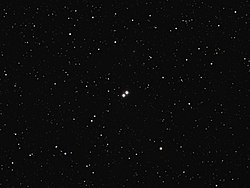| Observation data Epoch J2000.0 Equinox J2000.0 | |
|---|---|
| Constellation | Cygnus |
| 16 Cygni A | |
| Right ascension | 19h 41m 48.9535s[1] |
| Declination | +50° 31′ 30.220″[1] |
| Apparent magnitude (V) | 5.96 |
| 16 Cygni B | |
| Right ascension | 19h 41m 51.9727s[2] |
| Declination | +50° 31′ 03.089″[2] |
| Apparent magnitude (V) | 6.20 |
| Characteristics | |
| Spectral type | G1.5Vb / G2.5Vb / M?V |
| U−B color index | 0.19 / 0.20 |
| B−V color index | 0.64 / 0.66 |
| Variable type | None |
| Astrometry | |
| 16 Cyg A | |
| Radial velocity (Rv) | −27.31(13)[1] km/s |
| Proper motion (μ) | RA: −148.034(28) mas/yr[1] Dec.: −159.030(28) mas/yr[1] |
| Parallax (π) | 47.3239 ± 0.0197 mas[1] |
| Distance | 68.92 ± 0.03 ly (21.131 ± 0.009 pc) |
| Absolute magnitude (MV) | 4.29 |
| 16 Cyg B | |
| Radial velocity (Rv) | −27.87(12)[2] km/s |
| Proper motion (μ) | RA: −134.482(18) mas/yr[2] Dec.: −162.698(27) mas/yr[2] |
| Parallax (π) | 47.3302 ± 0.0171 mas[2] |
| Distance | 68.91 ± 0.02 ly (21.128 ± 0.008 pc) |
| Absolute magnitude (MV) | 4.53 |
| Details | |
| 16 Cyg A | |
| Mass | 1.08±0.02[3] M☉ |
| Radius | 1.229±0.008[3] R☉ |
| Luminosity | 1.55±0.07[3] L☉ |
| Surface gravity (log g) | 4.292±0.003[3] cgs |
| Temperature | 5,830 ± 11[4] K |
| Metallicity [Fe/H] | 0.101 ± 0.008[4] dex |
| Rotation | 23.8+1.5 −1.8 d[5] |
| Rotational velocity (v sin i) | 2.23 ± 0.07[5] km/s |
| Age | 7.07±0.26[3] Gyr |
| 16 Cyg B | |
| Mass | 1.04±0.02[3] M☉ |
| Radius | 1.116±0.006[3] R☉ |
| Luminosity | 1.25±0.05[3] L☉ |
| Surface gravity (log g) | 4.359±0.002[3] cgs |
| Temperature | 5,751 ± 11[4] K |
| Metallicity [Fe/H] | 0.054 ± 0.008[4] dex |
| Rotation | 23.2+11.5 −3.2 d[5] |
| Rotational velocity (v sin i) | 1.35 ± 0.08[5] km/s |
| Age | 6.74±0.24[3] Gyr |
| Other designations | |
| Database references | |
| SIMBAD | data |
| A data2 | |
| B data3 | |
16 Cygni or 16 Cyg is a triple star system approximately 69 light-years away from Earth in the constellation of Cygnus. It consists of two Sun-like yellow dwarf stars, 16 Cygni A and 16 Cygni B, together with a red dwarf, 16 Cygni C. In 1996 an extrasolar planet was discovered in an eccentric orbit around 16 Cygni B.
- ^ a b c d e Cite error: The named reference
Gaia DR3 Awas invoked but never defined (see the help page). - ^ a b c d e Cite error: The named reference
Gaia DR3 Bwas invoked but never defined (see the help page). - ^ a b c d e f g h i j Cite error: The named reference
Metcalfe2015was invoked but never defined (see the help page). - ^ a b c d Tucci Maia, Marcelo; Meléndez, Jorge; Ramírez, Iván (2014). "High Precision Abundances in the 16 Cyg Binary System: A Signature of the Rocky Core in the Giant Planet". The Astrophysical Journal. 790 (2): L25. arXiv:1407.4132. Bibcode:2014ApJ...790L..25T. doi:10.1088/2041-8205/790/2/L25. S2CID 118403440.
- ^ a b c d Davies, G. R; Chaplin, W. J; Farr, W. M; García, R. A; Lund, M. N; Mathis, S; Metcalfe, T. S; Appourchaux, T; Basu, S; Benomar, O; Campante, T. L; Ceillier, T; Elsworth, Y; Handberg, R; Salabert, D; Stello, D (2015). "Asteroseismic inference on rotation, gyrochronology and planetary system dynamics of 16 Cygni". Monthly Notices of the Royal Astronomical Society. 446 (3): 2959. arXiv:1411.1359. Bibcode:2015MNRAS.446.2959D. doi:10.1093/mnras/stu2331. S2CID 119110862.
